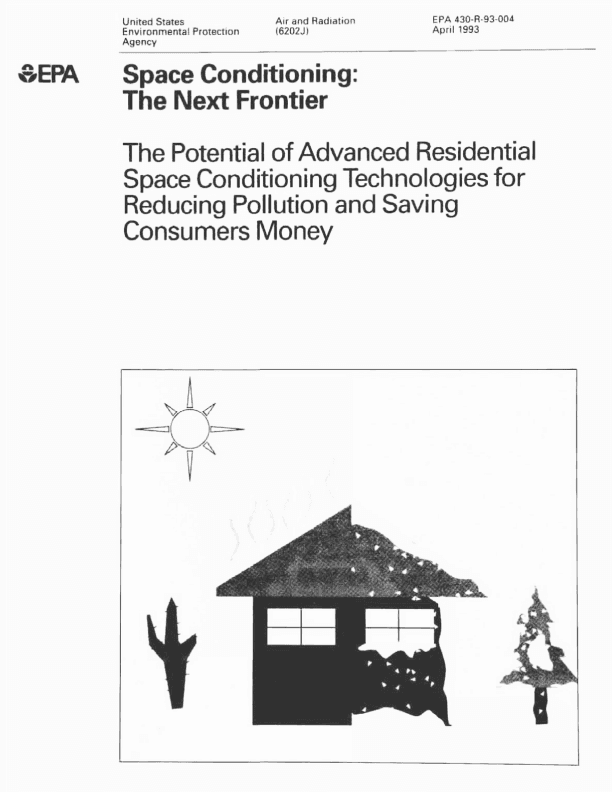Space Conditioning:The Next Frontier
This often quoted text from the Environmental Protection Agency (EPA) is a thorough examination of the advantages and disadvantages of advanced residential space conditioning equipment. With roughly 9% of the total U.S. end-use energy consumption going to residential heating and cooling equipment, this document explores how heat pumps (especially ground source heat pumps) can lower our overall energy use and support clean air initiatives in the years to come.
The paper compares ground-source, air-source and gas-fired heat pumps as well as advanced gas furnaces using a prototypical single family home in 6 distinct locations. The results show that the geothermal heat pump is universally the most energy efficient and has the greatest potential benefit for the individual and the nation as whole. The EPA issued this report in 1993 and since that time, the geothermal heat pump industry has made technological advances that have made equipment more reliable and more efficient than was possible at the time this paper was published.
Table of Contents
- Report’s Main Findings
- Executive Summary
- Background
- Comparative Analysis of Alternative Space Conditioning Systems
- Utility Cost-Effectiveness
- Environmental Impacts and Total Societal Costs
- The Market Potential for Advanced Space Conditioning Equipment
- Opportunities for Enhancing the Market for Advanced Space Conditioning Equipment
- Institutional Opportunities
- The Environmental Impacts of Residential Space Conditioning in the U.S.
- Introduction
- Barriers Against Efficiency in the Heating and Air Conditioning Market
- Utilities: The New Players in the Space Conditioning Appliance Market
- The Environmental Costs of Energy
- DSM for Space Conditioning as Practiced By Utilities
- EPA’s Pollution Prevention Strategies
- What This Report Seeks to Accomplish
- Review of Existing and Emerging Space Conditioning Technologies
- Overview of the Space Conditioning Market
- Present and Future Markets for Space Conditioning Equipment
- Technologies Assessed in the Report
- Electric Resistance Furnace with Central Air Conditioning
- Electric Air Source Heat Pump
- Standard Air Source Heat Pump
- High Efficiency Air Source Heat Pump
- Advanced Air Source Heat Pump
- Low-Cost Advanced Air Source Heat Pump
- Existing and Future Performance Improvement Options
- The Role of Substitute Refrigerants
- Electric Ground Source Heat Pumps
- Technology Design: A Mixed Blessing of Higher Performance and Higher Cost
- Ground Loop Configurations
- Ground Loop Costs
- Standard Ground Source Heat Pump
- Advanced Ground Source Heat Pump
- Emerging Ground Source Heat Pump
- Existing and Future Improvements in Ground Source Heat Pumps
- Oil Furnace with High Efficiency Air Conditioning
- Gas Furnaces
- Standard Gas Furnace with A/C
- Advanced Gas Furnace with A/C
- Emerging Gas-Fired Air Source Heat Pump
- Future Performance Improvement Options for Gas-Fired Heat Pumps
- Analysis of Space Conditioning Equipment: Economics, Environmental Effects and the Potential for Utility DSM Programs
- Scope of Analysis
- Space Conditioning Equipment and Cost Comparison
- Environmental Effects and Total Societal Cost
- Cost-Effectiveness Screening for Utility Programs
- The Performance and Operating Cost Superiority of Advanced Space
- Conditioning Technologies
- Comparison of the Most Advanced Technologies
- Source Operating Performance
- Total Annualized Cost
- Environmental Impacts of Space Conditioning Equipment
- Utility Cost-Effectiveness Tests
- Conclusions
- The Potential Market for Advanced Space Conditioning Equipment
- Introduction
- Background on Market Potential Analysis
- Potential for Emerging Ground Source Heat Pumps and Advanced Air Source Heat Pumps
- Climate Zone 1
- Climate Zone 2
- Climate Zone 3
- Climate Zone 4
- Climate Zone 5
- Total Opportunities in the U.S. for Emerging Ground Source Heat Pumps and Advanced Air Source Heat Pumps
- Potential for Gas-Fired Heat Pumps and Advance Gas Furnace Systems
- Climate Zone 1
- Climate Zone 2
- Climate Zone 3
- Climate Zone 4
- Climate Zone 5
- Total Opportunities in the U.S. for Advanced Gas Technologies
- Total Potential for Emissions Reductions from Advanced Space Conditioning Technologies
- Avoided Environmental Risk
- Additional Opportunities from Early Retirements
- Other Technologies
- Opportunities for Enhancing the Market for Advanced Space Conditioning Equipment
- Introduction
- Emerging Ground Source Heat Pumps
- Continuing Equipment Performance and Installation Improvements
- Development of Marketing and Delivery Infrastructure
- Advanced Air Source Heat Pumps
- Reducing First Cost
- Performance Improvements
- Gas-Fired Heat Pumps
- Product Reliability
- Product Cost
- Environmental Impact
- Advanced Gas Furnace Systems
- Options for Utility Action to Enhance the Advanced Space Conditioning Equipment Market
- Join in Partnerships with Other Utilities
- Sustained Effort
- Clear Efficiency Improvement Objectives
- Utility Program “Ramp-Up” Period
- Direct Manufacturer or Dealer Incentives
- Incentives for Continuous Improvements
- Market Expansion through Early Retirement
- Work to Attract Landlords and Builders as Participants
- Continuing Product Research and Development
- Alternatives to DSM: Market-Based Incentives
- Innovative Program Design – Alternatives to Rebates
- The Consortium for Energy Efficiency
- Energy Star HVAC Systems
- Opportunities in Export Markets
- Future EPA Plans for Space Conditioning Equipment

